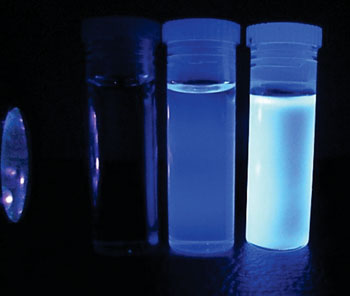Fluorescent Sensor Provides Low-Cost Diagnosis of Cystic Fibrosis
By LabMedica International staff writers
Posted on 17 Nov 2016
A new diagnostic test has been developed for cystic fibrosis and the new device provides a cheaper, easier way to detect levels of chloride in sweat, which are elevated in cystic fibrosis patients.Posted on 17 Nov 2016
Chloride is an essential electrolyte that maintains homeostasis within the body, where abnormal chloride levels in biological fluids may indicate various diseases such as cystic fibrosis (CF). However, current analytical solutions for chloride detection fail to meet the clinical needs of both high performance and low material or labor costs, hindering translation into clinical settings.

Image: Naturally fluorescing particles in body fluid samples were used to diagnose cystic fibrosis (Photo courtesy of Pennsylvania State University).
Bioengineers at the Pennsylvania State University (University Park, PA, USA) first developed a citrate-based dye that emits fluorescent light. In the presence of chloride, however, the amount of light given off by the molecule diminishes: the more chloride, the less fluorescence. Sweat from eight healthy and five CF individuals were collected from each arm at a sweat clinic, where sweat from the right arm was analyzed by mercuric nitrate titration.
Absorbance spectra for the new test were recorded on an Infinite M200 Pro UV-vis spectroscopy, and fluorescence spectra were recorded on a FluoroMax-4 fluorospectroscopy at concentrations below 0.1 optical density (OD). After creating a detection system based on this principle, the team compared it to the chloride-detection method currently used in the clinic and found both tests gave similar results. The new test can detect chloride over a wider range of concentrations and, because it's automated, it avoids the problem of human error.
Seila Selimovic, PhD, program director of National Institute of Biomedical Imaging and Bioengineering (Bethesda, MD, USA), said, “This is an important step towards faster, more reliable diagnosis. The new sensing technology is cheap and easy to apply and, if used as part of a point-of-care device may allow more clinics to provide early cystic fibrosis tests. That is a great thing for the developed world, but is a game changer for the economically developing world, since early intervention can save lives in dealing with this devastating and all too common disease.” The study was first published online on August 30, 2016, in the journal Chemical Science.
Related Links:
Pennsylvania State University
National Institute of Biomedical Imaging and Bioengineering













